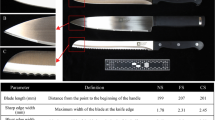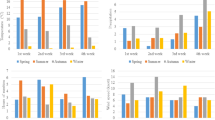Abstract
During a homicide investigation in which fire has been used to reduce the size of the cadaver and conceal the evidence of injuries, the identification of perimortem trauma presents a challenge, in particular in cases when the perpetrator has dismembered the body followed by burning the remains. It is therefore important to understand the effects which heat causes on fresh bone. The aim of this paper is to perform a pilot study on the survival ratio of toolmarks in different anatomical regions associated with dismemberment, and a descriptive analysis of the variables that may potentially influence the post-burning survival and detection. To achieve this, three donated embalmed cadavers were used to simulate a case in which an attempted dismemberment and burning had occurred. Fifty-five pre-burning injuries were manually induced: 30 using a machete to inflict chopping trauma, and 25 with a serrated bread knife to inflict sharp force trauma, on the thigh, knee, ankle and wrist. The cadavers were cremated in a furnace at Madrid’s Cementerio Sur and the burnt remains were analysed at the Laboratorio de Antropología y Odontología Forense of the Universidad Complutense de Madrid. Not all pre-burning injuries inflicted were visible after the cremation process; only 13% were detected in this experiment. Toolmarks can be masked, modified, destroyed or overlooked from the outset of the procedure due to several factors which influence the post-burning survival and detection of toolmarks and contribute to conceal the evidence of trauma. Additional research should be done to study further variables which affect the post-burning visibility of sharp force trauma.










Similar content being viewed by others
Data availability
Not applicable
References
Pokines JT, Symes SA (2013) Manual of forensic taphonomy. CRC Press, Boca Raton, London, New York
Wheatley BP (2008) Perimortem or postmortem bone fractures? An experimental study of fracture patterns in deer femora. J Forensic Sci 53:69–72. https://doi.org/10.1111/j.1556-4029.2008.00593.x
Byers SN (2016) Introduction to forensic anthropology. Taylor & Francis
Blau S (2017) How traumatic: a review of the role of the forensic anthropologist in the examination and interpretation of skeletal trauma. Aust J Forensic Sci 49:261–280. https://doi.org/10.1080/00450618.2016.1153715
Ubelaker DH (2009) The forensic evaluation of burned skeletal remains: a synthesis. Forensic Sci Int 183:1–5. https://doi.org/10.1016/j.forsciint.2008.09.019
Bohnert M, Rost T, Pollak S (1998) The degree of destruction of human bodies in relation to the duration of the fire. Forensic Sci Int 95:11–21. https://doi.org/10.1016/S0379-0738(98)00076-0
Alunni V, Grevin G, Buchet L, Quatrehomme G (2014) Forensic aspect of cremations on wooden pyre. Forensic Sci Int 241:167–172. https://doi.org/10.1016/j.forsciint.2014.05.023
Morcillo-Méndez MD, Campos IY (2012) Dismemberment: cause of death in the Colombian armed conflict. Torture 22(Suppl 1):5–13
Pachar Lucio JV (2019) Postmortem criminal mutilation in Panama. In: Dismemberments. Elsevier, pp 63–68
Breglia GA (2018) Descuartizamiento criminal. Estudio medicolegal del lugar del hecho y de la víctima. A propósito de un caso. Gac Int Ciencias Forenses 27:63–87
Petreca VG, Burgess AW, Stone MH, Brucato G (2020) Dismemberment and mutilation: a data-driven exploration of patterns, motives, and styles. J Forensic Sci 65:888–896. https://doi.org/10.1111/1556-4029.14274
Almond L, Pell C, McManus M (2018) Body part removal: a thematic exploration of U.K. homicide offenses. J Interpers Violence:1–20. https://doi.org/10.1177/0886260518814268
Ross AH, Humphries A, Cunha E (2019) The pattern of violence and aggression. In: Dismemberments. Elsevier, pp 183–194
Mata Tutor P, Villoria Rojas C (In press) Vayamos por partes - Desmembramiento y mutilación en España en los últimos 10 años. V Anu Int Criminol y Ciencias Forenses
Herrmann NP, Bennett JL (1999) The differentiation of traumatic and heat-related fractures in burned bone. J Forensic Sci 44:14495J. https://doi.org/10.1520/JFS14495J
Emanovsky P, Hefner JT, Dirkmaat DC (2002) Can sharp force trauma to bone be recognized after fire modification? An experiment using Odocoileus virginianus (white-tailed deer) ribs. Proc from Annu Meet Am Acad Forensic Sci 8:214–215
de Gruchy S, Rogers TL (2002) Identifying chop marks on cremated bone: a preliminary study. J Forensic Sci 47:15506J. https://doi.org/10.1520/JFS15506J
Pope EJ, Smith OC (2004) Identification of traumatic injury in burned cranial bone: an experimental approach. J Forensic Sci 49:1–10. https://doi.org/10.1520/JFS2003286
Marciniak S-M (2009) A preliminary assessment of the identification of saw marks on burned bone. J Forensic Sci 54:779–785. https://doi.org/10.1111/j.1556-4029.2009.01044.x
Poppa P, Porta D, Gibelli D, Mazzucchi A, Brandone A, Grandi M, Cattaneo C (2011) Detection of blunt, sharp force and gunshot lesions on burnt remains. Am J Forensic Med Pathol 32:275–279. https://doi.org/10.1097/PAF.0b013e3182198761
Kooi RJ, Fairgrieve SI (2013) SEM and stereomicroscopic analysis of cut marks in fresh and burned bone. J Forensic Sci 58:452–458. https://doi.org/10.1111/1556-4029.12050
Robbins SC, Fairgrieve SI, Oost TS (2015) Interpreting the effects of burning on pre-incineration saw marks in bone. J Forensic Sci 60:S182–S187. https://doi.org/10.1111/1556-4029.12580
Waltenberger L, Schutkowski H (2017) Effects of heat on cut mark characteristics. Forensic Sci Int 271:49–58. https://doi.org/10.1016/j.forsciint.2016.12.018
Koch S, Lambert J (2017) Detection of skeletal trauma on whole pigs subjected to a fire environment. J Anthropol Rep 02:1–7. https://doi.org/10.35248/2684-1304.17.2.113
Macoveciuc I, Márquez-Grant N, Horsfall I, Zioupos P (2017) Sharp and blunt force trauma concealment by thermal alteration in homicides: an in-vitro experiment for methodology and protocol development in forensic anthropological analysis of burnt bones. Forensic Sci Int 275:260–271. https://doi.org/10.1016/j.forsciint.2017.03.014
Alunni V, Nogueira L, Quatrehomme G (2018) Macroscopic and stereomicroscopic comparison of hacking trauma of bones before and after carbonization. Int J Legal Med 132:643–648. https://doi.org/10.1007/s00414-017-1649-8
Symes SA, Rainwater CW, Chapman EN et al (2015) Patterned thermal destruction in a forensic setting. In: Schmidt C, Symes SA (eds) The Analysis of Burned Human Remains. Elsevier, pp 17–59
Ross AH, Radisch D (2019) Toolmark identification on bone. In: Dismemberments. Elsevier, pp 165–182
Alunni-Perret V, Borg C, Laugier J-P, Bertrand MF, Staccini P, Bolla M, Quatrehomme G, Muller-Bolla M (2010) Scanning electron microscopy analysis of experimental bone hacking trauma of the mandible. Am J Forensic Med Pathol 31:326–329. https://doi.org/10.1097/PAF.0b013e3181e2ed0b
Sanabria-Medina C, Restrepo HO (2019) Dismemberment of victims in Colombia. In: Dismemberments. Elsevier, pp 7–41
Decreto 124/1997, del 9 de octubre, de la Comunidad Autónoma de Madrid
Wilson A, Serafin S, Seckiner D, Berry R, Mallett X (2019) Evaluating the utility of time-lapse imaging in the estimation of post-mortem interval: an Australian case study. Forensic Sci Int Synergy 1:204–210. https://doi.org/10.1016/j.fsisyn.2019.08.003
Kimmerle EH, Baraybar JP (2008) Sharp force trauma. In: Taylor & Francis Inc (ed) Skeletal trauma: identification of injuries resulting from human rights abuse and armed conflict. CRC Press, Boca Raton, pp. 263–314
Pachar Lucio JV (2015) Abordaje médico forense de los cuerpos mutilados criminalmente. Med Leg Costa Rica 32:41–50
Humphrey JH, Hutchinson DL (2001) Microscopic characteristics of hacking trauma. J Forensic Sci 46:228–233. https://doi.org/10.1520/JFS14955J
Fairgrieve SI (2008) Forensic cremation: recovery and analysis. CRC Press, Boca Raton
Grévin G, Bailet P, Quatrehomme G, Ollier A (1998) Anatomical reconstruction of fragments of burned human bones: a necessary means for forensic identification. Forensic Sci Int 96:129–134. https://doi.org/10.1016/S0379-0738(98)00115-7
Keaton MA (2012) Effect of embalming on the decomposition of pigs
Amadasi A, Mazzarelli D, Oneto C et al (2019) Dismemberment and toolmark analysis on bone. In: Dismemberments. Elsevier, pp 113–131
Symes S, Williams J, Murray E, Hoffman J, Holland T, Saul J, Saul F, Pope E (2001) Taphonomic context of sharp-force trauma in suspected cases of human mutilation and dismemberment. In: Haglund WD, Sorg MH (eds) Advances in forensic Taphonomy: method, theory, and archaeological perspectives. CRC Press, Boca Raton, Fla, pp 403–434
Hernández Mier C, Ortega Madrid A (2016) Reporte De Caso: Decapitación Y Desmembramiento Del Cuerpo; Lesiones Postmortem Con Sierra De Cinta. Case Report: decapitation and dismemberment of the body. Gac Int Ciencias Forenses 19:17–21
Winskog C, Byard RW (2016) Decapitation: a rare form of postmortem mutilation. Forensic Sci Med Pathol 12:98–100. https://doi.org/10.1007/s12024-015-9714-4
Acknowledgements
We would like to express our gratitude to the funerary services of Madrid, Spain (Servicios Funerarios de la Comunidad de Madrid) for supporting this project and for the technical assistance provided during the use of the cremation furnace, through the cooperation agreement signed in 2017 with the Universidad Complutense of Madrid, Spain. We would also like to thank the Forensic Anthropology and Odontology Lab members at Universidad Complutense de Madrid for their help during the sharp force trauma experiment and validation. Finally, we kindly thank Daniel García Rubio for his assistance in designing the tables and figures.
Author information
Authors and Affiliations
Contributions
Pilar Mata Tutor: conceptualization; methodology; investigation; writing—original draft; writing—review and editing; visualization. Nicholas Márquez-Grant: supervision; writing—review and editing. Catherine Villoria Rojas: investigation. Inés Pérez Guzmán: investigation. Alexandra Muñoz: investigation. María Benito Sánchez: investigation, supervision, resources.
Corresponding author
Ethics declarations
Conflict of interest
The authors declare that they have no conflict of interest.
Ethical approval
This experiment was carried out in accordance with the Code of Ethics of the World Medical Association (Declaration of Helsinki) and falls within the scope of the Mortuary Health Act of the Autonomous Region of Madrid (Decree 124/1997, of October 9, 1997) [31].
Informed consent
Not applicable
Code availability
Not applicable
Additional information
Publisher’s note
Springer Nature remains neutral with regard to jurisdictional claims in published maps and institutional affiliations.
Highlights
• Three donated embalmed cadavers were used to simulate a case in which an attempted dismemberment and posterior burning had occurred.
• Only 13% of the injuries inflicted were visible after cremation.
• Toolmarks can be masked, modified, destroyed or overlooked throughout the process due to intrinsic and extrinsic factors.
• Sharp implements can lead to different post-burning survival of toolmarks depending on how the trauma was inflicted.
Supporting Junior Scientists
The first author (PMT) is under 35 years old
Electronic supplementary material
Annex 1
– Individual 1 during the burning process at 35 min (JPG 129 kb)
Annex 2
– Individual 2 during the burning process at 38 min (JPG 2528 kb)
Annex 3
– Individual 3 during the burning process at 75 min (JPG 2859 kb)
Annex 4
– Left: Induced sharp force trauma with the serrated knife (blue) and the machete (red) all shown in anatomical position. For more information of the precise injuries in individuals 1, 2 and 3 see Table 2. Right: Observed sharp force trauma with the serrated knife (blue) and the machete (red) all shown in anatomical position. For more information of the precise toolmarks in individuals 1, 2 and 3 see Table 8. (PNG 159 kb)
Annex 5
– Weight of anatomical regions (g) (DOCX 19 kb)
Rights and permissions
About this article
Cite this article
Mata Tutor, P., Márquez-Grant, N., Villoria Rojas, C. et al. Through fire and flames: post-burning survival and detection of dismemberment-related toolmarks in cremated cadavers. Int J Legal Med 135, 801–815 (2021). https://doi.org/10.1007/s00414-020-02447-1
Received:
Accepted:
Published:
Issue Date:
DOI: https://doi.org/10.1007/s00414-020-02447-1




